Introduction What Where How And When Exercises
Question 1. Match the following
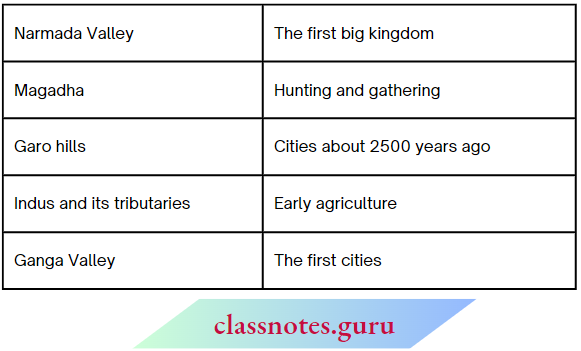
Answer:
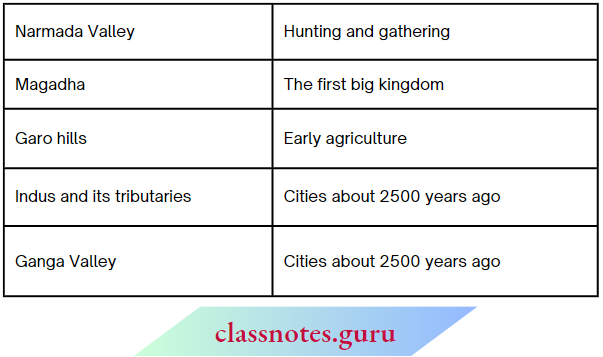
Read and Learn More NCERT Solutions For Class 6 Social Science
Question 2. List one major difference between manuscripts and inscriptions.
Answer:
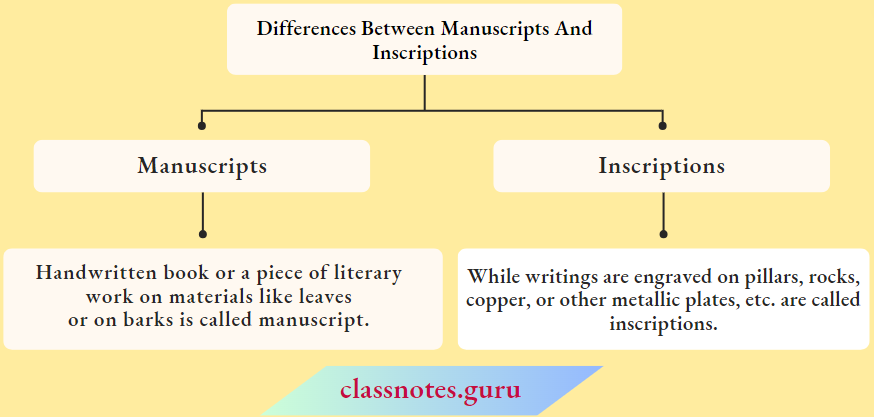
Question 3. Return to Rasheeda’s question. Can you think of some answers to it?
Answer:
Yes, I can think of some answers to it.
- We can learn about the past by studying history. We can use manuscripts, inscriptions, or old objects.
- History will help us understand how this present evolved. It will tell us about the past of the present.
Question 4. Make a list of all the objects that archaeologists may find. Which of these could be made of stone?
Answer:
While exploring and excavating archaeologists may find tools, weapons, pots, ornaments, coins, remains of buildings, inscriptions sculptures, paintings, etc.
Out of these sculptures, building remains, could have been made of stone.
Question 5. Why do you think ordinary men and women did not generally keep records of what they did?
Answer:
We think ordinary men and women did not generally keep records of what they did due to the following reasons:
- Ordinary Men And Women did not know the art of writing in the beginning.
- Ordinary Men And Women were not interested in such work.
- Ordinary Men And Women do not know the importance of keeping records of the events. The lack of historical sense was mainly responsible for it.
Question 6. Describe at least two ways in which you think the lives of kings would have been different from those of farmers.
Answer:
- Kings set up large kingdoms and lived in palaces whereas the farmers lived in small houses or huts. There was a difference in their food, dress, and way of living.
- Kings depended on farmers for the production of food and at least in this matter farmers were self-dependent.
- Kings kept records of their lives, wars, victories, etc.
Question 7. List at least five different crafts that you know about today. Are the craftspersons
- Men
- Women
- Both men and women?
Answer:
- The Crafts That We Know About Today Are: Weavers, Blacksmiths, goldsmiths, carpenters, masons, etc.
- In all these crafts we find men and women both.
There are crafts like masons, plumbers, carpenters, etc. where we generally find men.
Question 8. What were the subjects on which books were written in the past? Which of these would you like to read?
Answer:
In the past books were written on subjects like religious beliefs and practices, medicine, poetry, the lives of kings and their victories, science, epics, etc. It would be interesting to read the Vedas, epics, or books about the lives of kings.
Introduction What Where How And When Very Short Answer Type Questions
Question 1. Where did the early people live?
Answer:
Early people lived along the banks of the river Narmada.
Question 2. Write the name of the region where rice was first of all grown in India.
Answer:
The region where rice was first of all grown in India is to the north of the Vindhyas.
Question 3. Name the countries that form South Asia.
Answer:
India, Pakistan, Bangladesh, Nepal, Bhutan, Sri Lanka, Afghanistan, Iran, China Myanmar, etc. form South Asia.
Question 4. Why is South Asia called a subcontinent?
Answer:
South Asia is called a subcontinent because, although it is smaller than a continent, it is very large and is separated from the rest of Asia by seas, hills, and mountains.
Question 5. Write important historical events against the following important dates:
- 8,000 years ago
- 4,700 years ago
- 2,500 years ago
- 2,000 AD ICE
Answer:
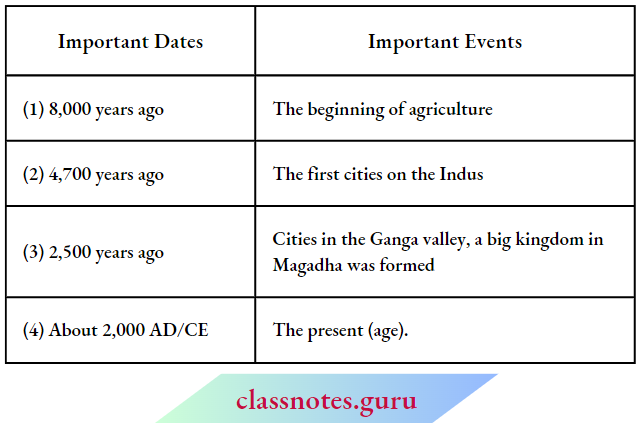
Question 6. Distinguish between historical and pre-historical periods.
Answer:
The period for which we have written records is called historical age or period, while the period for which we have no written records is called pre-historical age or period.
Question 7. Name two main groups (or categories) of historical sources.
Answer:
- Archaeological sources (for example: physical remains inscriptions, coins, etc.).
- Literary sources (such as religious books, manuscripts, foreign, travelers’ accounts, etc.).
Question 8. Where are Sulaiman, Kirthar, and Garo Hills located?
Answer:
Sulaiman and Kirthar Hills are located in modern-day Pakistan.
Garo Hills are located in Meghalaya in north-east India.
Question 9 Which animals were reared by the people of Sulaiman and Kirthar hills?
Answer:
Sheep and goat.
Question 10. What are tributaries? Give an example.
Answer:
Tributaries are small rivers that join a bigger river, for example, Son a tributary of the Ganga.
Question 11. What was the job of religious teachers?
Answer:
The religious teachers moved from place to place and offered advice and instructions to people.
Question 12. Write about the occupations of the people of Andaman Island.
Answer:
Fishing, hunting, and collecting forest produce are the main occupations of people of the Andaman Island.
Question 13. What is the work of a historian?
Answer:
Historians find the information from manuscripts and inscriptions. They reconstruct the past from the sources that they find.
Question 14. Why do people travel nowadays?
Answer:
Nowadays people travel in search of livelihood, adventure, trade, or as a tourist.
Introduction What Where How And When Short Answer Type Questions
Question 1. What can we know about the past?
Answer:
We can know several things about the past like
- We can find out—what people ate, the kinds of clothes they wore, the houses in which they lived.
- We can find out about hunters, herdsmen, farmers, rulers, merchants, priests, craftsmen, artists, artists, musicians, and scientists.
- We can also find out the games children played, the stories they heard, the dramas (or plays) they saw or enjoyed, and the songs they sang.
Question 2. Where did the people live in Stone Age?
Answer:
The Way of Life of the People in the Stone Age
- Some of the earliest people lived along the banks of rivers. They were skilled gatherers.
- They knew about the vast wealth of plants in the surrounding forests and collected roots, fruits, and other forest products for their food.
- The people in the Stone Age also hunted animals and birds. They used to catch fish also.
- Some of the areas where the people first began to grow crops such as wheat and barley about 8000 years ago are located in river-valley areas.
They also began rearing animals like sheep, goats, dogs, cows, horses and other cattle.
Question 3. When did the early cities develop in India?
Answer:
- About 4700 years ago some of the earliest cities flourished on the banks of the Indus and its tributaries.
- And other early cities developed on the banks of the Ganga and its tributaries and along the sea coasts, about 2500 years ago.
Question 4. What do you know about Magadha?
Or
Name the first largest Indian empire. Write two to three sentences about it.
Answer:
- Magadha was the first largest empire in India.
- The area along some of the important rivers of Northern India and to the south of the Ganga was known as Magadha.
- Magadha rulers were very powerful. (Chandragupta Maurya, Samrat Ashoka)
- Magadha set up a large kingdom. (Some smaller kingdoms were set up in other parts of the country as well).
Question 5. Explain the following terms in short.
- BC
- AD
- CE
- BCE
- Script
Answer:
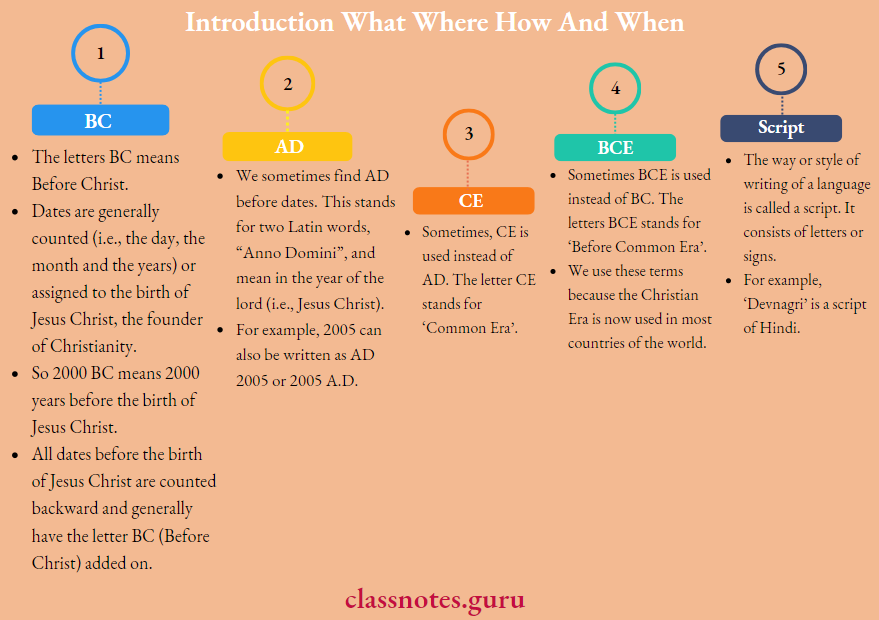
Question 6. What types of dangers were faced by the travelers?
Answer:
- Travelers had to face the difficult physical features of deserts, rough seas, or mountains like the Himalayas.
- Travelers had to face the consequences of natural disasters. Most of the time people travelled in groups or caravans.
Question 7. Who are archaeologists?
Answer:
- Archaeologists study the remains of the past, like objects, remains of buildings, etc.
- They explore and excavate tools, weapons pots, pans, coins, etc., and study paintings and sculptures.
- They look for the bones of animals to find what people ate in the past.
Question 8. What were the advantages of writing on a hard surface? And what were the difficulties?
Answer:
- Inscriptions were written on hard surfaces like metal or stone.
- Inscriptions survived the test of time as they could not be eaten away by insects.
- Inscriptions were not destroyed by severe climate or natural calamities.
- Inscriptions would have been difficult to inscribe on hard surfaces as it required tools and skill.
Introduction What Where How And When Long Answer Type Questions
Question 1. How did our country get its name?
Answer:
Names Of Our Country
- Two of the words we generally use for our country are India and Bharat. The word India comes from the Indus called Sindhu in Sanskrit.
- The Iranians and the Greeks who came through the northwest about 2500 years ago, were familiar with the Indus, called the Hindos or the Indos. The land to the east of the river (i.e., the Indus) is called India.
- The name Bharat was used by a group of people who lived in the northwest, which is also mentioned in the Rigveda, the earliest composition in Sanskrit (dated to about 3500 years ago). Later, it was used for the country.
Question 2. Briefly describe the different ways of finding out about our pasts.
Answer:
There are different ways to know about our pasts:

Introduction What Where How And When Map Skills
Question 1. Locate Sulaiman, Kirthar, Garo, and Vindhyas and Trace river, river Ganga, and their tributaries.
Answer:
- Sulaiman, Krithar: North-west
- Garo: Northwest
- Vindhyas: Central INDIA
- Tributaries Of Indus : Jhelum, Ravi, Sultej, Beas, Chenab.
- Tributaries of Gang : Son, Chambal

Introduction What Where How And When Multiple Choice Questions Choose The Correct Answer
Question 1. Which river’s bank did the people live along in the ancient time?
- Ganga
- Narmada
- Sutlej
- None of these
Answer: 2. Narmada
Question 2. Which city was established on the banks of the Ganga?
- Magadha
- Vindhyas
- Both (1) and (2)
- None of these
Answer: 1. Magadha
Question 3. How did merchants travel?
- With Caravans
- By Ships
- Both (1) and (2)
- None of these
Answer: 3. Both (1) and (2)
Question 4. From where did the Iranians and the Greeks come?
- North-west
- North-east
- North-south
- None of these
Answer: 1. North-west
Question 5. Where were the manuscripts preserved?
- In temples and monasteries
- In museums
- Both (1) and (2)
- None of these
Answer: 1. In temples and monasteries
Question 6. How did the people of the Andaman Islands get their food?
- By fishing
- By hunting
- By collecting the forest products
- All of these
Answer: 4. All of these
Question 7. What helps us to find out the records of hunters, fishing folk, etc.?
- Archaeology
- Astrology
- Biology
- All of these
Answer: 1. Archaeology
Question 8. In what ways the ancient coin was different from the ones we use today?
- It was made of stones
- It was made from baked clay
- It was made of bones
- All of these
Answer: 4. All of these
Question 9. In which language most of the manuscripts were written?
- Sanskrit
- English
- Hindi
- None of these
Answer: 1. Sanskrit
